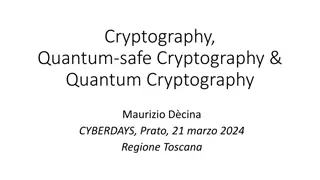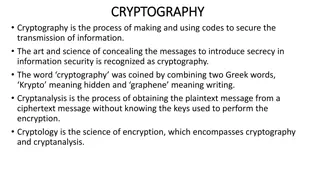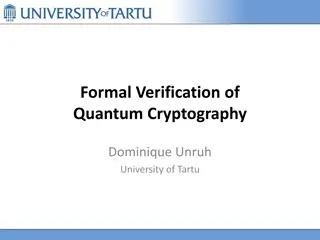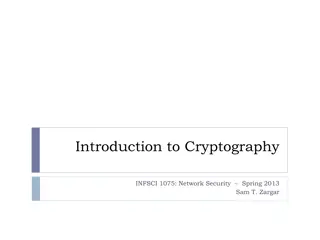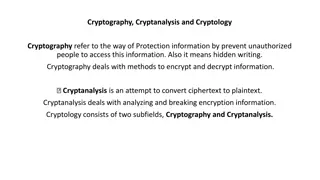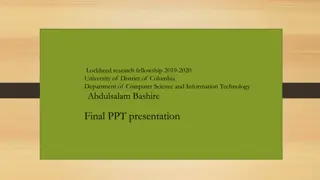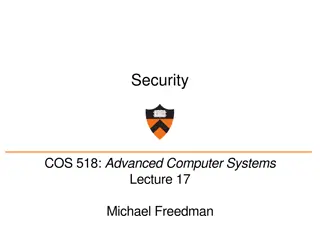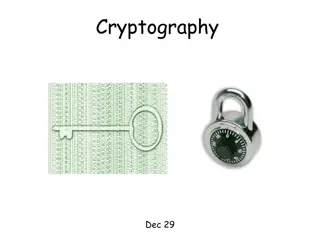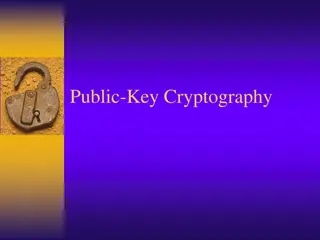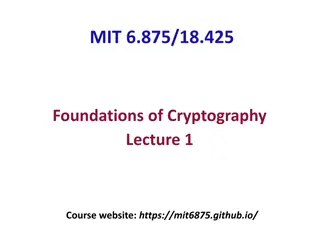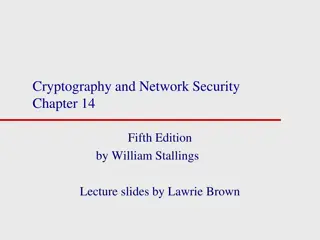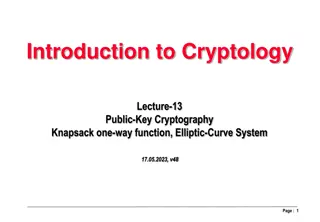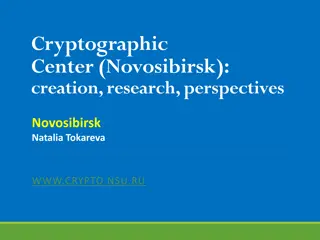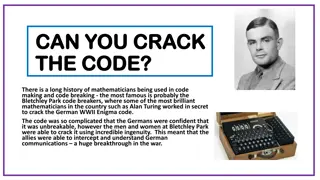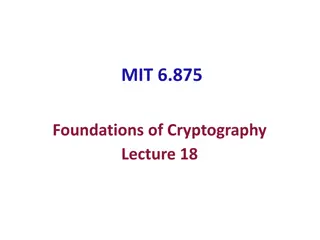History of Cryptography: Techniques, Evolution, and Impact
Delve into the fascinating world of cryptography through the ages, from ancient substitution ciphers to modern cipher devices. Explore the birth of cryptanalysis, polyalphabetic substitution, black chambers, and the development of innovative cipher devices post-WWI. Uncover the pivotal role cryptography plays in secure communication, digital security, and privacy today.
Download Presentation

Please find below an Image/Link to download the presentation.
The content on the website is provided AS IS for your information and personal use only. It may not be sold, licensed, or shared on other websites without obtaining consent from the author.If you encounter any issues during the download, it is possible that the publisher has removed the file from their server.
You are allowed to download the files provided on this website for personal or commercial use, subject to the condition that they are used lawfully. All files are the property of their respective owners.
The content on the website is provided AS IS for your information and personal use only. It may not be sold, licensed, or shared on other websites without obtaining consent from the author.
E N D
Presentation Transcript
History of Cryptography Amir Boumezbeur Saeed Osman
What is Cryptography? - Cryptography is the practice and study of techniques for secure communication. Historically, cryptography has been used to convey secret messages. Nowadays, cryptography is the driving force behind digital security and privacy. - -
Early Cryptography - First known evidence of cryptography was on an inscription in an Ancient Egyptian tomb in 1900 BC. Early cryptography largely consisted of substitution ciphers. Atbash cipher was a monoalphabetic cipher used by Hebrew scholars in 500 BC Caesar Cipher was used by Julius Caesar in Ancient Rome. - - -
Birth of Cryptanalysis - Cryptanalysis is the study of analysing and decrypting codes - Al-Kindi first to describe frequency analysis in the 9th century - Letters occur in varying frequencies - Take advantage of known frequency patterns - Effective in deciphering basic substitution ciphers - Sample size to be taken into consideration
Polyalphabetic substitution - First known polyalphabetic substitution cipher made by a mane named Leon Battista Alberti Polyalphabetic substitution ciphers use multiple substitution alphabets. Effective in combating frequency analysis Most well known example is the Vigenere cipher, invented in 1500s - Strongest cipher for centuries - Cracked by Charles Babbage and Friedrich Kasiski independently in mid 1800s. - - -
Black Chambers - With the propagation of the use of ciphers in Europe, it became a political necessity to intercept and break secret messages. - Existed in nearly every European nation beginning in the 1500s - Dedicated government departments that were tasked with creating and breaking cryptograms of foreign nations - These secretariats existed all the way up to the 20th century.
Cipher Devices - After WWI, nations needed new ways to encrypt and hide messages from enemies. Four men from four nations created their own variations of electromechanical cipher devices and they all used typewriters and rotors. Boris Hagelin modified Koch s machine by adding wheels and pins to represent an alphabet and made it pocket-sized called the C-36. On 1950, he manufactured 140,000 devices for the US Army and became the first cryptographic millionaire. - - -
The Enigma Machine - On 1926, the German Army and Navy took Dr.Arthur Scherbius original Enigma device and altered it to a Military version. A large self inverse plugboard machine that takes 6 to 10 pairs of letters and encrypts them, the pair of letters can be upto 150 trillion different combinations. The British, French and Polish, all tried and failed to decode the machine On 1939, Alan Turing joined the GCCS and built the bombe, elinimates as many wrong combinations as possible and was the biggest step towards the British successfully breaking the Enigma. - - -
Lucifer Cipher and DES - On 1968, Dr.Horst Fesital joined IBM and created an 128 bit block cipher algorithm called Lucifer. On 1973, the NBS and NSA adopted Lucifer and used it to implement the DES. It uses one key to encrypt and decrypt 64-bit data. Main innovation and started a new era of the cryptography market. Spawned variations such as; IDEA, RC4, RC5, RC and the AES. Building blocks of the ATM and micro-transactions between bank accounts. - - -
RSA Algorithm - - First Public-key cryptosystem, used to secure data transmission Asymmetric encryption system that generates two keys, public(for encryption) and private(for decryption). Most commonly used in E-commerce and online business. Nowadays, used to pass encrypted keys and used in bulk encryptions. Built and used on the basics of humanity: Trust. - - -


